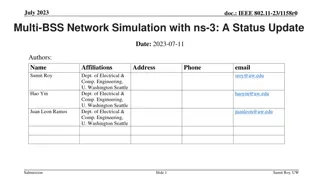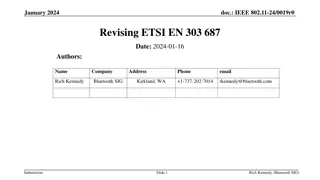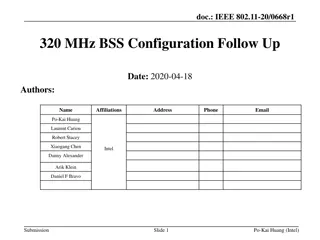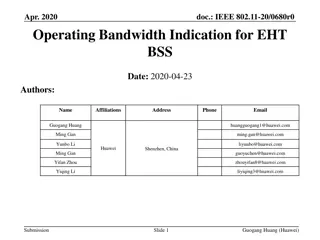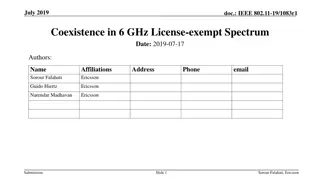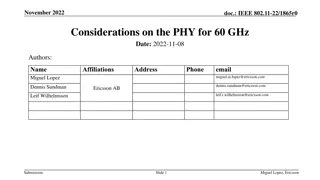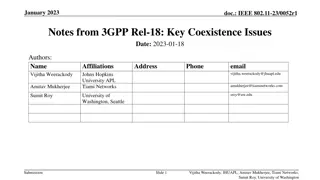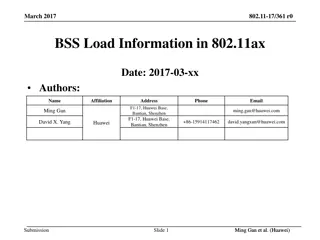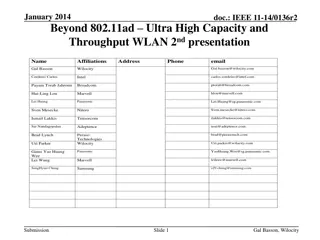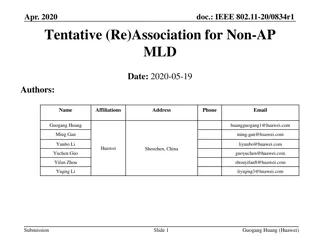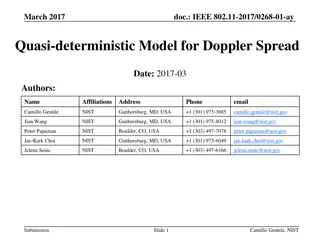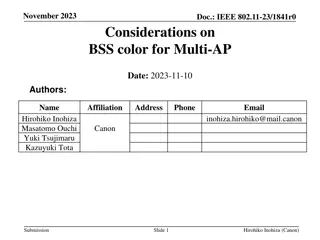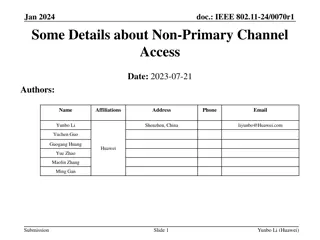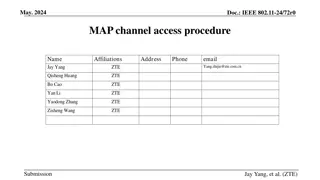802.11aj 45 GHz Channel Access and BSS Operation Framework Proposal
This document outlines a proposal for channel operation and BSS operation in the 45 GHz frequency bands for 802.11aj in China. It includes details on channelization, spectrum allocation, maximum transmit power, and BSS configuration rules. The aim is to meet the functional requirements specified while ensuring consistency with existing 802.11 systems. Key points cover channel bandwidth, channel access rules, and user experience requirements for activities like video streaming and internet access.
Download Presentation

Please find below an Image/Link to download the presentation.
The content on the website is provided AS IS for your information and personal use only. It may not be sold, licensed, or shared on other websites without obtaining consent from the author. Download presentation by click this link. If you encounter any issues during the download, it is possible that the publisher has removed the file from their server.
E N D
Presentation Transcript
May 2015 doc.: IEEE 802.11-15/0558r0 802.11aj (45 GHz) Channel Access and BSS Operation Date: 2015-05-12 Authors: Name Company Address Phone email Weimin Xing Bo Sun ZTE Corp. Kaibo Tian Liguang Li Shiwen He Haiming Wang SEU Submission Slide 1 Weimin Xing, ZTE Corp.
May 2015 doc.: IEEE 802.11-15/0558r0 Abstract Base on the channelization of 45GHz, we propose a framework for the channel operation in China 45 GHz frequency bands for 802.11aj, meeting the requirements specified in the functional requirements documents. Further, we also propose a basic rules for channel access in China 45 GHz frequency bands for 802.11aj. Submission Slide 2 Weimin Xing, ZTE Corp.
May 2015 doc.: IEEE 802.11-15/0558r0 45 GHz Channelization Submission Slide 3 Weimin Xing, ZTE Corp.
May 2015 doc.: IEEE 802.11-15/0558r0 China 45 GHz Spectrum Allocation and Channelization Frequency band: 42.3~47.0 GHz, 47.2~48.4 GHz Bandwidth: 1080 MHz, 540 MHz Frequency tolerance: 100 10-6 Maximum transmit power at antenna port: 20dBm Maximum EIRP: 36dBm 42.3 GHz 47.0 GHz 47.2 GHz 48.4 GHz CH 1 CH 2 CH 3 CH 4 CH 5 CH 6 CH 7 CH 8 CH 9 CH 10 B0 = 540 MHz CH 1 CH 2 CH 3 CH 4 CH 5 B0 = 1080 MHz Channelization: Allows for 10 independent BSSs using channel bandwidth of 540 MHz. Allows for 5 independent BSSs using channels bandwidth of 1080 MHz. A mixture of both should be enough for logical channel requirements in most deployment scenarios. Submission Slide 4 Weimin Xing, ZTE Corp.
May 2015 doc.: IEEE 802.11-15/0558r0 45 GHz BSS Operation Submission Slide 5 Weimin Xing, ZTE Corp.
May 2015 doc.: IEEE 802.11-15/0558r0 Some Requirements for 45 GHz User experience for 45 GHz should be in consistence with that of existing 802.11 systems. A maximum target PHY transmission rate over Gbps to be met as specified in the FRD. Operating usages like video streaming, file transfer, internet access etc. Submission Slide 6 Weimin Xing, ZTE Corp.
May 2015 doc.: IEEE 802.11-15/0558r0 Scope of BSS Operation (1/2) Channel Setup efficiently support 45 GHz channelization PCP/AP may select to operate in one of the ten 540 MHz channels or one of the five 1080 MHz channel when it starts. PCP/AP may dynamically change its channel number with corresponding change in channel bandwidth. For a BSS occupying a 1080 MHz bandwidth channel, data transfer can be through 540 MHz bandwidth or 1080 MHz bandwidth Submission Slide 7 Weimin Xing, ZTE Corp.
May 2015 doc.: IEEE 802.11-15/0558r0 Scope of BSS Operation (2/2) OBSS Mitigation When two BSSs have devices overlapping in service area, or movement of BSSs to a common service area, Smooth translation to co-operative interference mitigations. Transparent merging of different BSSs using co-operative interference mitigations. Submission Slide 8 Weimin Xing, ZTE Corp.
May 2015 doc.: IEEE 802.11-15/0558r0 Channel Operation Solutions Requirements Meet objectives of proposed channel access. Efficiently fulfills the requirements for co-operative interference mitigations in densely populated environments. Efficiently handle OBSS mitigations. A general channel operation solution was proposed in next few slides. NOTE, the details of the general channel operation solution is not yet completed and we call for interested parties to contribute. Submission Slide 9 Weimin Xing, ZTE Corp.
May 2015 doc.: IEEE 802.11-15/0558r0 Proposed solution (2/4) The primary channel of a 1.08 GHz channel is predefined, e.g., Channel 2 is the primary channel within Channel 1 If a PCP/AP intends to start its BSS in a free 540 MHz channel, it selects the primary channel as the first option to transmit its beacon/notification frames. If occupied, it selects the secondary channel. Primary or Secondary Channel NP DTI BI If both 540 MHz channels are occupied but no PCP/AP operates in this 1.08 GHz channel, a PCP/AP may select either primary or secondary channel to start its BSS. If both 540 MHz channels are occupied and there exists at least one PCP/AP operates in this 1.08 GHz channel, a PCP/AP must select the primary channel to start its BSS. Submission Slide 10 Weimin Xing, ZTE Corp.
May 2015 doc.: IEEE 802.11-15/0558r0 Proposed solution (2/4) If a PCP/AP intends to start its BSS in a free 1.08 GHz channel, it will transmit beacon/notification frames in the primary channel only. NP Primary Channel DTI Secondary Channel BI If no 1.08 GHz channel is free, a PCP/AP select the 1.08 GHz operating channel based on the following priority orders: 1) The secondary channel is free. 2) All the existing PCPs/APs operate in the primary channel only. 3) All the existing PCPs/APs either operate in the primary channel or operate in the secondary channel. Submission Slide 11 Weimin Xing, ZTE Corp.
May 2015 doc.: IEEE 802.11-15/0558r0 Proposed solution (3/4) Suppose that a PCP/AP 1 operates in a 1.08 GHz Channel, e.g., Channel 1, with transmitting beacon/notification frames in a predefined or selected primary channel only, e.g., Channel 2. Another PCP/AP 2 that intends to operate in 1.08 GHz channel must also transmit beacon/notification frames in Channel 2. Another PCP/AP 3 that intend to operate in 540 GHz channel can start in Channel 2 only. Switch to another unoccupied channel PCP/AP 2 PCP/AP 3 PCP/AP 1 Beacon SP0 @ Channel 1 Beacon SP1 @ Channel 1 Beacon SP2 @ Channel 1 540 MHz Channel 2 ... NP NP NP 540 MHz Channel 3 Submission Slide 12 Weimin Xing, ZTE Corp.
May 2015 doc.: IEEE 802.11-15/0558r0 Proposed solution (4/4) Suppose that PCP/AP 1 operates in a 540 GHz Channel. Another PCP/AP 2 that intends to operate in 1.08 GHz channel must transmit beacon/notification frames in the predefined or selected primary channel, e.g., Channel 2. o If PCP/AP 1 was operating in Channel 3, PCP/AP 2 must notify the PCP/AP 1 to switch its BSS to Channel 2 or at least transmit beacon/notification frames in Channel 2. (How to notify is TBD.) Another PCP/AP 3 that intend to operate in 540 GHz channel may select either Channel 2 or Channel 3 to start if no PCP/AP operates in Channel 1 now; otherwise, it can only start in Channel 2. Switch to another unoccupied channel. PCP/AP 1 PCP/AP 2 PCP/AP 3 Beacon SP0 @ Channel 1 Beacon SP1 @ Channel 1 Beacon SP2 @ Channel 1 540 MHz Channel 2 ... NP NP NP 540 MHz Channel 3 Movement of PCPs/APs is TBD. Submission Slide 13 Weimin Xing, ZTE Corp.
May 2015 doc.: IEEE 802.11-15/0558r0 45 GHz Channel Access Submission Slide 14 Weimin Xing, ZTE Corp.
May 2015 doc.: IEEE 802.11-15/0558r0 Scope of Channel Access Channel Access: Channel access mechanisms: contention based access, contention free access Dynamic allocations of channel resources. Multi-bandwidth: dynamic bandwidth negotiation Submission Slide 15 Weimin Xing, ZTE Corp.
May 2015 doc.: IEEE 802.11-15/0558r0 Channel Access mechanisms Supports reservation based allocations as well as contention based allocations Allocate SPs for devices so that the quality of service (QoS) is guaranteed when required. Allocate CBAPs for contention based access to cater to intermittent channel access. SP1 CBAP2 540 MHz 1080 MHz CBAP3 SP3 SP2 CBAP1 SP3 540 MHz Submission Slide 16 Weimin Xing, ZTE Corp.
May 2015 doc.: IEEE 802.11-15/0558r0 Dynamic allocation Supports dynamic allocate/truncate/extend SPs or CBAPs Dynamic allocation of channel resources is employed to allocate channel time during scheduled allocations. A STA truncates an allocation to release the remaining time in the allocation. Dynamic extension of allocation to extend the allocated time in the current allocation. The additional time can be used to support variable bit rate traffic, for retransmissions or for other purposes. Submission Slide 17 Weimin Xing, ZTE Corp.
May 2015 doc.: IEEE 802.11-15/0558r0 Dynamic bandwidth operation Dynamic bandwidth negotiation: Dynamic bandwidth operation is needed when multi- bandwidth is introduced to 45GHz Dynamic bandwidth operation is proposed in IEEE 802.11ac, which allows narrower bandwidth transmission if one or more secondary channels are sensed busy. The RTS/CTS exchange is used to negotiate a potentially channel width for subsequent transmissions within the current TXOP. Submission Slide 18 Weimin Xing, ZTE Corp.
doc.: IEEE 802.11-15/0558r0 Dynamic Bandwidth Operation for 45GHz Dynamic bandwidth operation: With dynamic bandwidth subfield set to 1, RTS in duplicate format is transmitted over 1080 MHz channel that is sensed free at the initiator. If network allocation vector(NAV) indicates idle at the responder: If clear channel assessment(CCA) on the secondary channel has been idle for a point coordination function interframe space(PIFS) period prior to the start of the RTS frame, CTS frame in duplicate format is sent over the 1080 MHz channel. Otherwise, CTS is sent only on the primary 540 MHz channel. If NAV indicates busy at the responder, no CTS is responded. Initiator transmits data only over channel indicated free by CTS. DIFS+ backoff Primary 540 channel data RTS CTS PIFS Interference at responder Secondary 540 channel RTS Submission
doc.: IEEE 802.11-15/0558r0 Static Bandwidth Operation for 45GHz Static bandwidth operation : With dynamic bandwidth subfield set to 0, RTS in duplicate format is transmitted over 1080 MHz channel that is sensed free at the initiator. If NAV indicates free at the responder and CCA on the secondary channel has been idle for a PIFS period prior to the start of the RTS frame , CTS frame in duplicate format is sent over the 1080 MHz channel. If the secondary channel has been sensed busy at the responder, the initiator will not receive CTS and then it shall invoke the back-off procedure to retransfer the RTS. DIFS+ backoff DIFS+ backoff Primary 540 channel Secondary 540 channel PIFSRTS PIFS RTS CTS Data CTS RTS RTS Interference at responder Submission
doc.: IEEE 802.11-15/0558r0 The Flowchart of Dynamic Bandwidth Received RTS in duplicate format dynamic bandwidth = 1 (preamble scheme adopts the 1080 MHz PHY) Dynamic bandwidth operation for IEEE 802.11aj is illustrated in the flowchart. N Does NAV indicate free? Y N Does CCA indicate the secondary channel idle? Y Respond CTS in duplicate format over the 1080 MHz channel (dynamic bandwidth = 1) (preamble scheme adopts the 1080 MHz PHY) Respond CTS over the 540 MHz channel (dynamic bandwidth = 1) (preamble scheme adopts the 540 MHz PHY) Dont respond CTS Submission
May 2015 doc.: IEEE 802.11-15/0558r0 TXOP Power Save Allow STAs that are not targeted by the AP to enter doze state until the end of the TXOP On receipt of a PPDU, the STA determines that the COLOR in the RXVECTOR parameter does not match the COLOR indicated by the AP to which the STA is associated. With the matching COLOR, the RXVECTOR parameter PARTIAL_AID is not equal to 0 nor does it match the STA s partial AID. With the matching partial AID, the RA in the MAC header of the corresponding frame that is received correctly does not match the MAC address of the STA. 540 MHz STAs receive a Beacon frame or a Set PCO frame that contains the PCO Phase field equal to 1. In a received PSMP frame, the STA finds that the STA_AID field is not its AID nor does the PSMP Group Address ID match its Group Address . The STA receives a frame intended for it with the More Data field equal to 0 and the Ack Policy subfield in the QoS Control field is equal to No Ack or sends an acknowledgment if Ack Policy subfield is not equal to No Ack. Submission Slide 22
May 2015 doc.: IEEE 802.11-15/0558r0 Proposed changes Base on Draft P802.11REVmc D4.0, we proposed to add/modify the following subclauses in the complete proposal of 802.11aj (45GHz) 9.xx QMG channel access 9.xx.1 General 9.xx.2 Access period within a BI ...... 9.xx.a CBAP transmission 9.xx.b SP transmission 9.xx.c Dynamic bandwidth negotiation . 10.xx QMG BSS Operation 10.xx.1 Basic QMG BSS functionality 10.xx.2 Channel selection methods for a QMG BSS 10.xx.3 Scanning requirements for QMG STA 10.xx.a 540/1080MHz QMG BSS operation 10.xx.b Channel switching methods for a QMG BSS 10.xx.c Communicating 540/1080MHz BSS coexistence information Submission Slide 23
May 2015 doc.: IEEE 802.11-15/0558r0 Conclusion We propose a framework for the BSS operation and channel access in China 45 GHz, which include: BSS operation: One 540 MHz channel is defined for each 1080 MHz channel, e.g. Channel 1/3/5/7/9 are defined as primary channel; A PCP/AP working on 540 MHz channel shall transmit beacon on its working channel; A PCP/AP working on 1080 MHz channel shall transmit beacon on the primary 540 MHz channel of its working channel Some compliance mechanisms may be employed to immigrate the interference from a BSS on the secondary 540 MHz channel to a 1080 MHz BSS Channel access: Supports reservation based allocations as well as contention based allocations Allow dynamic allocate channel time for data transfer Supports dynamic bandwidth operation like 802.11ac Submission Slide 24
May 2015 doc.: IEEE 802.11-15/0558r0 Reference IEEE 802.11-13/1365r2 45 GHz Spectrum Allocation in China Submission Slide 25 Weimin Xing, ZTE Corp.
Mar 2015 doc.: IEEE 802.11-15/0558r0 Thank YOU Submission Slide 26 Weimin Xing, ZTE Corp.
Mar 2015 doc.: IEEE 802.11-15/0558r0 Appendix: Channel setup scenairos Submission Slide 27 Weimin Xing, ZTE Corp.
May 2015 doc.: IEEE 802.11-15/0558r0 Channel Setup Scenario 1 Pre-requisite No BSS established within a 1080 MHz channel, Channel 1 (as illustrated). Possible channel setup choices for incoming PCP/AP Operate within either of the 540 MHz channels (Channel 2 or Channel 3). Operate in the 1080 MHz bandwidth channel, Channel 1. Option 1: Use of fixed primary channel (i.e. Channel 2) for BSS control. Option 2: PCP/AP dynamically choose between Channel 2 or Channel 3 as the primary channel. Submission Slide 28 Weimin Xing, ZTE Corp.
May 2015 doc.: IEEE 802.11-15/0558r0 Channel Setup Scenario 2 Pre-requisite: One BSS established within either Channel 2 or Channel 3. Possible channel setup choices for incoming PCP/AP Operate within the free 540 MHz channel. Search for a free 1080 MHz bandwidth channel (i.e. Channel 4, 7 etc) if so desired. Operate within the 1.08GHz channel and share the spectrum with existing 540MHz BSS. Submission Slide 29 Weimin Xing, ZTE Corp.
May 2015 doc.: IEEE 802.11-15/0558r0 Channel Setup Scenario 3 (1/3) Pre-requisite: All possible channels are occupied. Possible channel setup choices for incoming PCP/AP Operate within any 540MHz channel and share the spectrum with existing 540/1080MHz BSS Operate within any 1.08GHz channel and share the spectrum with existing 540/1080MHz BSS Submission Slide 30 Weimin Xing, ZTE Corp.
May 2015 doc.: IEEE 802.11-15/0558r0 Channel Setup Scenario 3 (2/3) Some considerations for spectrum sharing method in Scenario 3 For easy interference mitigations. Guaranteed QoS requirements Protected transmission period for network co-ordination. Fairness among different BSSs. Splitting of 1080 MHz channel to two 540 MHz channels. Interleaved time block sharing of spectrum resources through coordination between PCP/APs. Clustering mechanism with interleaved protected period for different BSSs. Submission Slide 31 Weimin Xing, ZTE Corp.
May 2015 doc.: IEEE 802.11-15/0558r0 Channel Setup Scenario 3 (3/3) BSS 1 @1080 MHz BSS 1 @540 MHz BSS 2 @540 MHz BSS 2 1080 MHz BSS 1 Submission Slide 32 Weimin Xing, ZTE Corp.



